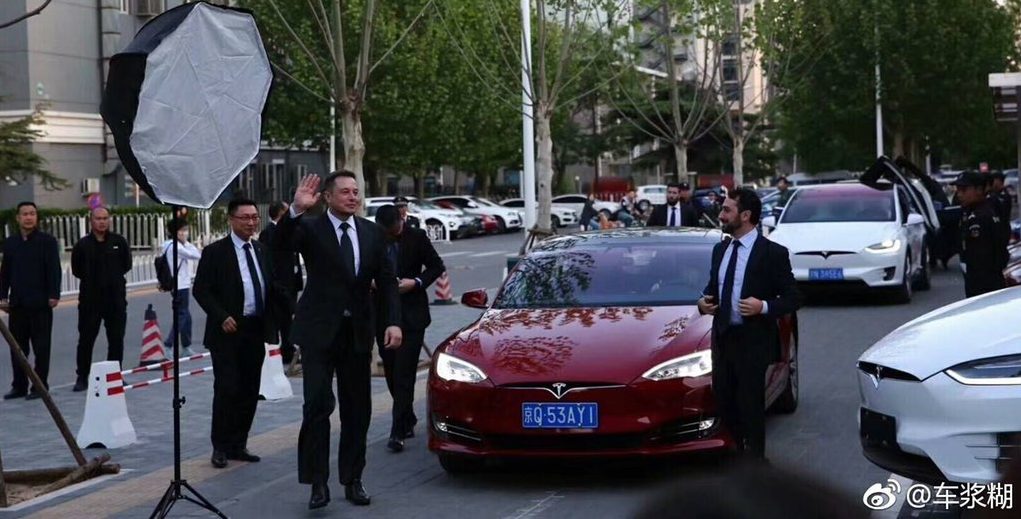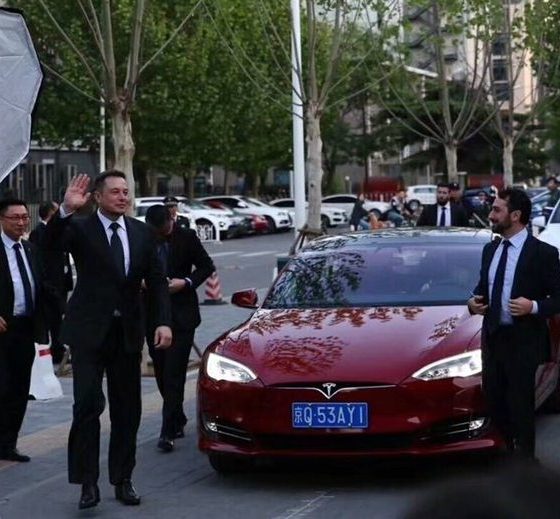

Investor's Corner
Tesla’s timeline for Gigafactory 3 in China is actually pretty conservative
Following reports that Tesla CEO Elon Musk has signed a preliminary agreement with Chinese authorities to build a solely-owned facility in Shanghai, questions have been raised by Wall St. skeptics and investors alike on how the California-based electric carmaker plans to fund development of its overseas factory.
Dubbed Gigafactory 3, the planned facility in China is expected to produce as many as 500,000 electric vehicles per year, doubling the production capacity of Tesla’s current facilities, and begin construction once permits and approvals are completed.
Tesla noted on Tuesday that vehicle production at Gigafactory 3 would start roughly two years after its construction begins, and ramp to a 500,000 vehicle per year production rate within 2-3 years. Such an aggressive timeline is classic Elon Musk, especially considering that components of Gigafactory 3, such as the advanced manufacturing robots and machinery that would be used to build the vehicles, would likely be coming from abroad. In a recent segment of Bloomberg Markets, Consumer Edge Research senior auto analyst James Albertine stated that the timeline of Gigafactory 3’s construction is simply “not feasible.”
While aiming to have its first electric cars roll off Gigafactory 3’s vehicle assembly lines within two years from construction is undoubtedly an ambitious goal, Tesla’s target dates are a lot more conservative than what critics would think. For one, Gigafactory 3 is being built in China, a country with a construction workforce that is optimized for quick, large-scale projects. This is something that Musk had mentioned back in February, when he noted that China’s progress in advanced infrastructure is “more than 100 times faster than the US.”
Musk’s statement on Twitter about China’s advanced infrastructure is reflected by feats of construction from the country’s workforce. Earlier this year, 1,500 workers in Eastern China set up a track replacement for a train station in just 8.5 hours. A time-lapse video of the event became viral, mainly due to the project having been conducted with near-surgical precision. Back in 2015, China also made headlines for its rapid construction after Broad Sustainable Building, a prefab construction firm in the Hunan province, managed to complete a 57-story skyscraper in just 19 days using a modular building method.
Also, if Tesla’s Nevada Gigafactory is any indication, the entire facility does not need to be completed before it can start its operations. Tesla started brush clearing and grading the land for Gigafactory 1 in the summer of 2014, and as of date, the expansive battery factory is still less than 30% complete. Despite this, the facility has already stepped up to provide enough battery packs to support the ongoing ramp for the Model 3, which recently managed to exceed a rate of 5,000 vehicles per week.
Drawing parallels to the sequence of events that have taken place at Tesla’s Nevada-based Gigafactory 1 over the years, reaching completion of several key sections in the China factory would be enough for the company to begin manufacturing of its vehicles without prior to full factory buildout. Considering the speed of China’s workforce, these key sections would likely be finished earlier than Tesla’s estimated two-year timeline.

Shanghai Municipal Party Committee Secretary Li Qiang meets with Elon Musk. [Credit: Weibo]
If there is one thing that could put a damper on the rapid development of Tesla’s China factory, it would be the funding needed for the ambitious project. Gigafactory 1 in Nevada, which produces battery packs, motors, and drivetrains, is estimated to cost around $5 billion when complete. Gigafactory 3, which incorporates both battery and vehicle production, would likely be in the same ballpark, if not more expensive.
With the state of Tesla’s finances today, the company has three main options to come up with the money to build Gigafactory 3. Tesla could go back to the equity market to fund the facility’s construction, just as it has done before. The company could also raise “debt” financing, however, its credit rating may have an impact on the company’s ability to negotiate favorable terms. One likely option that would allow Tesla to quickly fund the development of its factory in China is to partner with local investment banks. One of Tesla’s largest shareholders, China-based Tencent, already owns a 5% stake in the company.
There is also a fairly good chance that Tesla would receive major subsidies and tax relief from the Chinese government. The country, after all, is aggressively pushing electric cars as a preferred mode of transportation, with the country aiming to sell 2 million electric vehicles by 2020 and attain an ICE to EV ratio of 1:1 by 2030. With these own goals in mind, it does appear that it would be in China’s best interests to ensure that Tesla manages to build Gigafactory 3 without any difficulty. After all, the faster Tesla can start building its vehicles like the Model Y crossover SUV and some of the Model 3 in China, the better it would be for the country’s electric car market.

Investor's Corner
Tesla stock closes at all-time high on heels of Robotaxi progress

Tesla stock (NASDAQ: TSLA) closed at an all-time high on Tuesday, jumping over 3 percent during the day and finishing at $489.88.
The price beats the previous record close, which was $479.86.
Shares have had a crazy year, dipping more than 40 percent from the start of the year. The stock then started to recover once again around late April, when its price started to climb back up from the low $200 level.
This week, Tesla started to climb toward its highest levels ever, as it was revealed on Sunday that the company was testing driverless Robotaxis in Austin. The spike in value pushed the company’s valuation to $1.63 trillion.
Tesla Robotaxi goes driverless as Musk confirms Safety Monitor removal testing
It is the seventh-most valuable company on the market currently, trailing Nvidia, Apple, Alphabet (Google), Microsoft, Amazon, and Meta.
Shares closed up $14.57 today, up over 3 percent.
The stock has gone through a lot this year, as previously mentioned. Shares tumbled in Q1 due to CEO Elon Musk’s involvement with the Department of Government Efficiency (DOGE), which pulled his attention away from his companies and left a major overhang on their valuations.
However, things started to rebound halfway through the year, and as the government started to phase out the $7,500 tax credit, demand spiked as consumers tried to take advantage of it.
Q3 deliveries were the highest in company history, and Tesla responded to the loss of the tax credit with the launch of the Model 3 and Model Y Standard.
Additionally, analysts have announced high expectations this week for the company on Wall Street as Robotaxi continues to be the focus. With autonomy within Tesla’s sights, things are moving in the direction of Robotaxi being a major catalyst for growth on the Street in the coming year.
Elon Musk
Tesla needs to come through on this one Robotaxi metric, analyst says
“We think the key focus from here will be how fast Tesla can scale driverless operations (including if Tesla’s approach to software/hardware allows it to scale significantly faster than competitors, as the company has argued), and on profitability.”

Tesla needs to come through on this one Robotaxi metric, Mark Delaney of Goldman Sachs says.
Tesla is in the process of rolling out its Robotaxi platform to areas outside of Austin and the California Bay Area. It has plans to launch in five additional cities, including Houston, Dallas, Miami, Las Vegas, and Phoenix.
However, the company’s expansion is not what the focus needs to be, according to Delaney. It’s the speed of deployment.
The analyst said:
“We think the key focus from here will be how fast Tesla can scale driverless operations (including if Tesla’s approach to software/hardware allows it to scale significantly faster than competitors, as the company has argued), and on profitability.”
Profitability will come as the Robotaxi fleet expands. Making that money will be dependent on when Tesla can initiate rides in more areas, giving more customers access to the program.
There are some additional things that the company needs to make happen ahead of the major Robotaxi expansion, one of those things is launching driverless rides in Austin, the first city in which it launched the program.
This week, Tesla started testing driverless Robotaxi rides in Austin, as two different Model Y units were spotted with no occupants, a huge step in the company’s plans for the ride-sharing platform.
Tesla Robotaxi goes driverless as Musk confirms Safety Monitor removal testing
CEO Elon Musk has been hoping to remove Safety Monitors from Robotaxis in Austin for several months, first mentioning the plan to have them out by the end of 2025 in September. He confirmed on Sunday that Tesla had officially removed vehicle occupants and started testing truly unsupervised rides.
Although Safety Monitors in Austin have been sitting in the passenger’s seat, they have still had the ability to override things in case of an emergency. After all, the ultimate goal was safety and avoiding any accidents or injuries.
Goldman Sachs reiterated its ‘Neutral’ rating and its $400 price target. Delaney said, “Tesla is making progress with its autonomous technology,” and recent developments make it evident that this is true.
Investor's Corner
Tesla gets bold Robotaxi prediction from Wall Street firm
Last week, Andrew Percoco took over Tesla analysis for Morgan Stanley from Adam Jonas, who covered the stock for years. Percoco seems to be less optimistic and bullish on Tesla shares, while still being fair and balanced in his analysis.

Tesla (NASDAQ: TSLA) received a bold Robotaxi prediction from Morgan Stanley, which anticipates a dramatic increase in the size of the company’s autonomous ride-hailing suite in the coming years.
Last week, Andrew Percoco took over Tesla analysis for Morgan Stanley from Adam Jonas, who covered the stock for years. Percoco seems to be less optimistic and bullish on Tesla shares, while still being fair and balanced in his analysis.
Percoco dug into the Robotaxi fleet and its expansion in the coming years in his latest note, released on Tuesday. The firm expects Tesla to increase the Robotaxi fleet size to 1,000 vehicles in 2026. However, that’s small-scale compared to what they expect from Tesla in a decade.
Tesla expands Robotaxi app access once again, this time on a global scale
By 2035, Morgan Stanley believes there will be one million Robotaxis on the road across multiple cities, a major jump and a considerable fleet size. We assume this means the fleet of vehicles Tesla will operate internally, and not including passenger-owned vehicles that could be added through software updates.
He also listed three specific catalysts that investors should pay attention to, as these will represent the company being on track to achieve its Robotaxi dreams:
- Opening Robotaxi to the public without a Safety Monitor. Timing is unclear, but it appears that Tesla is getting closer by the day.
- Improvement in safety metrics without the Safety Monitor. Tesla’s ability to improve its safety metrics as it scales miles driven without the Safety Monitor is imperative as it looks to scale in new states and cities in 2026.
- Cybercab start of production, targeted for April 2026. Tesla’s Cybercab is a purpose-built vehicle (no steering wheel or pedals, only two seats) that is expected to be produced through its state-of-the-art unboxed manufacturing process, offering further cost reductions and thus accelerating adoption over time.
Robotaxi stands to be one of Tesla’s most significant revenue contributors, especially as the company plans to continue expanding its ride-hailing service across the world in the coming years.
Its current deployment strategy is controlled and conservative to avoid any drastic and potentially program-ruining incidents.
So far, the program, which is active in Austin and the California Bay Area, has been widely successful.








